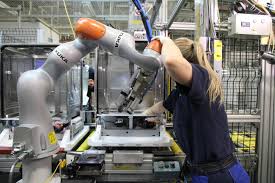Source: supplychainquarterly.com
Business delays caused by the Covid-19 crisis will eliminate an estimated $450 million of mobile robot revenues in 2020, but the sector is forecast to bounce back in 2021 and recoup more than the difference over the long term, a new study says.
The loss of sales in autonomous mobile robots (AMRs) and automated guided vehicles (AGVs) is being caused by delays in both new project signoffs and in project commissioning due to social distancing measures, according to Ash Sharma, research director at the research firm Interact Analysis.
However, that impact of the pandemic will eventually be overturned by continuing trends like the increased adoption of e-commerce, moves to local manufacturing, and desire to reduce dependency on human labor, concludes the report, “Covid-19 Will Eliminate $0.5 billion Mobile Robot Revenues in 2020, but Market Predicted to Nearly Double in 2021.”
“Despite the short-term challenges caused by the pandemic, we predict that the ‘lost’ revenue in 2020 will be more than overturned over the next three years and 2023 revenues will be nearly $600 million higher than they would have been if the pandemic had not occurred,” Sharma wrote in the report.
In the meantime, the robot producers most heavily impacted by the pandemic will be vendors focused on durable manufacturing (particularly automotive), which typically require higher capital expenditure demand more complex integration and commissioning. Adding to those troubles, the biggest current adopters of robotics–apparel and general merchandise–also comprise the vendors that are suffering the most from the pandemic, he said.
By the same logic, the pandemic has actually created new opportunities for those mobile robot vendors that offer low-cost approaches, such as rentals and robotics as a service (RaaS), which now present extremely compelling solutions that allow a fast ramp-up for retailers, Sharma said. Similarly, some AMR vendors are able to ship their robots and provide commissioning support remotely to circumvent any social distancing restrictions.
Therefore, demand will continue to be reasonably high in 2020 for order fulfillment AMRs, such as goods-to-person, person-to-goods, and sortation robots. While installations and revenues will likely be significantly lower than they could have been prior to the virus, the Interact Analysis forecast still predicts nearly 70% growth in revenues for those players. Looking farther into the future, the report says that AGV revenues are predicted to grow by more than 70% in 2021 after a flat year in 2020, and AMR revenue growth will be even more impressive, predicted to double in 2021.
The report follows an ongoing debate over whether that rising adoption of robots creates or destroys workers’ jobs.
Earlier this month, Massachusetts Institute of technology (MIT) economist Daron Acemoglu released a study finding that industrial robots replace human workers. According to the study, from 1990 to 2007, adding one additional robot per 1,000 workers reduced the national employment-to-population ratio by about 0.2%, although some areas of the U.S. were affected far more than others. This means each additional robot added in manufacturing replaced an average of 3.3 workers nationally. The increased use of robots in the workplace also lowered wages by roughly 0.4% during the same time period.
“We find fairly major negative employment effects,” Acemoglu said in an advance edition of the report, “Robots and Jobs: Evidence from U.S. Labor Markets,” which is scheduled for publication in the Journal of Political Economy. “We find negative wage effects, that workers are losing in terms of real wages in more affected areas, because robots are pretty good at competing against them.”
In response, the Germany-based trade group International Federation of Robotics (IFR) on Monday called Acemoglu’s research “wrong” and said that recent experience in the US, Europe, and Asia proves that robot adoption will more likely be a critical determinant of productivity growth for the post-Covid-19 economy.
According to IFR’s statistics, employment in the U.S. automotive industry – the nation’s largest adopter of robots – increased by 22% from 824,400 to 1,005,000 jobs between 2013 and 2018, despite a rise in the global operational stock of robots by about 65% to 2.4 million units over the same period.
“The impact of automation on employment is not in any respect different from previous waves of technology-driven change,” IFR President Milton Guerry said in a release. “Productivity increases and competitive advantages of automation don’t replace jobs – they will automate tasks, augment jobs and create new ones.”


